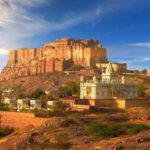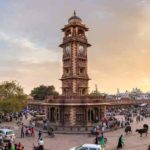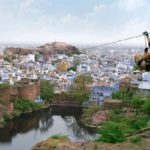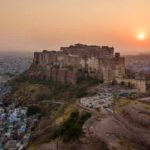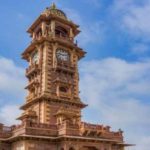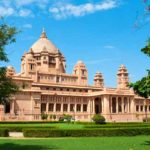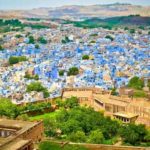A Travel Guide To Mehrangarh Fort, Jodhpur majestic Mehrangarh, one of Rajasthan’s finest forts, looks down protectively on the city. The fort is located at a height of around 125 metres and covers a total area of 5 square kilometres, with seven gates. The tiny, not-too-steep hill could be driven up or walked to the top. The steep rock face from which the tall and huge sandstone wall of Mehrangarh rises, whether viewed from a car or on foot, appears incredible.
The Mehrangarh Fort is located in the centre of the city, at an altitude of around 125 metres. It covers a 5-square-kilometer area. The fort includes seven gates, the most notable of which are the Jayapol, which was built by Maharaja Man Singh in 1806; Fatehpol, or the Victory Gate, which was built by Maharaja Ajit Singh; and the Lohapol, or the Iron Gate, which was created by Maharaja Ajit Singh. The sati marks of Maharaja Man Singh’s widows who hurled themselves upon his cremation pyre in 1843 can be seen next to the Lohapol. On the wall, one can see the strategically located cannons.
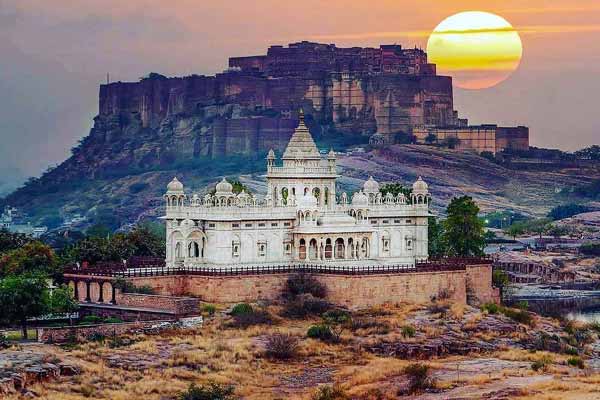
A sequence of gardens and palaces greet visitors inside the fort. The palace apartments exhibit a magnificent collection of Indian royal accoutrements. Thousands of tourists visit the fort each year to see the Rajput warriors’ artillery system. From the fort, one may get a bird’s eye perspective of the city.
From the summit, majestic Mehrangarh, one of Rajasthan’s finest forts, looks down protectively on the city. The fort is located at a height of around 125 metres and covers a total area of 5 square kilometres, with seven gates. The tiny, not-too-steep hill could be driven up or walked to the top. Driving or walking up, the sheer rock face from where emerges the tall and massive sandstone wall of Mehrangarh looks awesome indeed.
In front of the mammoth gate of A Travel Guide To Mehrangarh Fort, you can find a bearded Jodhpur resident, dressed in traditional threads, complete with turban, sword, shield and hookah welcoming the tourists. You can also find a couple of local musicians singing to the local tunes. I bought the requisite tickets and set off to explore the palaces, hallways and set off to explore the palaces, hallways and courtyards of Mehrangarh.
It is a royal treat, as one passes through the carefully preserved regalia and regal artefacts. Phool Mahal, Sukh Mahal, Moti Mahal. Exquisitely decorated ceilings and walls, with delicate lattice work on the windows. Large and unusual wooden statues, painted bright, adorned a palace section amongst an assortment of princely cradles. It is a labyrinth of wonders, not knowing what the next doorway might lead to.
Through the various avenues and routes of this sprawled complex, you will reach the fort roof, overlooking the entire city of Jodhpur, from over rows of medieval cannons. What a commanding view! The thousands of white houses chequered with ones painted blue.
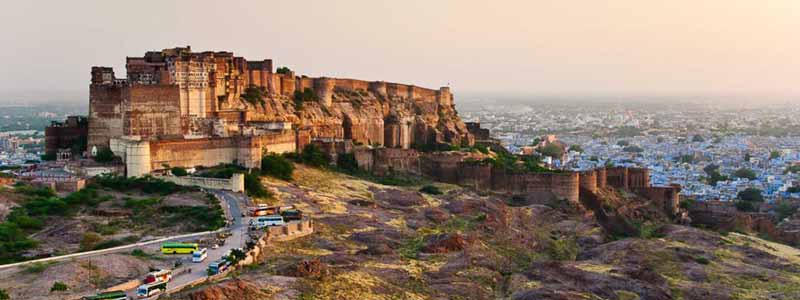
History of Mehrangarh Fort
Mehrangarh means ‘Fort of the sun’. The fort is perched on a rocky cliff called ‘Bhakur-chiria’ which means ‘mountain of birds’. The construction of the fort was started by Rao Jodha in the mid-fifteenth century.
A lot of additions and alterations were made in the later centuries by the subsequent rulers too. This resulted in different styles and architecture in the various parts of the fort.
Museum inside Mehrangarh Fort exhibits various items like palanquins, textiles, paintings, decorative arts and furniture etc that were used by the royal family during the 17th, 18th and 19th century.
Most of these items are a part of Maharaja Gaj Singh II’s personal collection. Maharaja Gaj Singh II is the current head of the Rathore clan and the custodian of the A Travel Guide To Mehrangarh Fort.
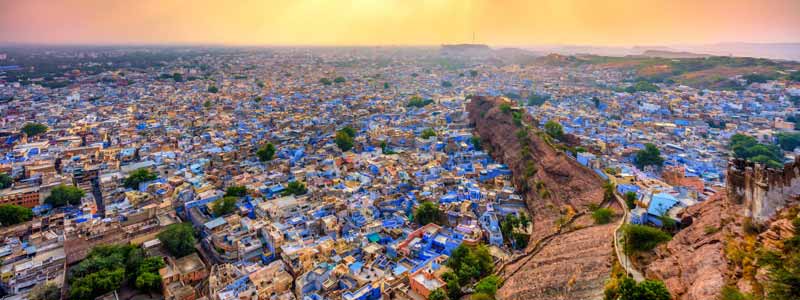
Architecture of Mehrangarh Fort
Mehrangarh fort is a magnificent edifice of 68-ft wide and 117-ft elevated walls.
There are seven gates of entry to the fort. The most famous among them is the Jaya Pol meaning victory, constructed by Maharaja Man Singh to celebrate his success over the armies of Jaipur and Bikaner. Fatteh Pol, which also means victory gate, was raised by Maharaja Ajit Singh to celebrate the defeat of the Mughals. Dedh Kamgra Pol, still bear the mutilations of cannonballs. Loha Pol, another gate to the fort have the handprints (sati marks) of the ranis who immolated themselves on the funeral pyre of their husband, Maharaja Man Singh, A Travel Guide To Mehrangarh Fort.
Impressive cenotaphs dot the fort which testify the valor of the Rathore kings of Jodhpur. The chhatri of Kirat Singh Soda, the honorable soldier who died guarding the fort against the Amber armies is a wonderful specimen.
The brilliant craftsmanship is exhibited by the fascinating sandstone palaces within the Fort. Explore the grand palaces like the Moti Mahal or the Pearl Palace, where you can marvel at the royal throne of Jodhpur known as the Sringar Chowki. The Phool Mahal has a beautiful ceiling adorned by gold filigree work. The Umaid Villas showcase beautiful Rajput miniature paintings while the Ajit Villas displays the musical instruments and the royal attires. The Rang Mahal, Chandan Mahal and Maan Vilas are exquisite splendors.
The fort also encloses the Mehrangarh Fort Museum. It has all exhibits of the olden days, like the royal palanquins, miniature paintings, furniture, and historic armory etc.
Interesting Facts of Mehrangarh Fort Jodhpur
- According to a popular folklore, it is believed that, to develop the Mehrangarh Fort, the Rao Jodha displaced a hermit called Cheeria Nathji (The lord of birds), who was the hill’s lone human occupant, Being angry upon this forced displacement, Cheeria Nathji cursed Rao Jodha that his kingdom will suffer from serious scarcity of water and even today the area is plagued by a drought every 3 to 4 years.
- In order to ensure fortunate of the Fort, Rao Jodha buried a man called “Raja Ram Meghwal” alive in the foundations and promised him that his family will be taken good care of, in return of this sacrifice. Even today, his descendants live in the fort, in an estate named after the Raja Ram Meghwal, “Raj Bagh” A Travel Guide To Mehrangarh Fort.
Best Time to Visit the Mehrangarh Fort in Jodhpur
The ideal time to visit this royal splendor is throughout the winters. During October to March, the weather is pleasurable and it is the best time to explore this stunning fort. If you see visit during this period, you can also belong of the international events that happen right here. Scroll to read more about them!
How To Reach Mehrangarh Fort in Jodhpur
You can fly to Jodhpur to explore this stunning fort. Jodhpur has its own domestic airport and is connected through flights to major cities of India. Jodhpur is also attached to different cities via a variety of trains including the lavish ‘Palace on Wheels’. One can also take the government or private buses or travel by road in hired or private cars.
Once in Jodhpur, reaching to Mehrangarh is a easy task. You can work with auto rickshaws or take a taxi to the fort since that the frequency of city buses is not really high in Jodhpur. If you remain in old town, the fort is a plain 2 km away and also around 10 km from the city centre A Travel Guide To Mehrangarh Fort.

